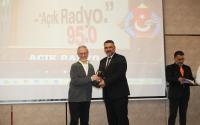16 September 2007The GuardianPeter Beaumont
The head of Israel's airforce, Major-General Eliezer Shkedi, was visiting a base in the coastal city of Herziliya last week. For the 50-year-old general, also the head of Israel's Iran Command, which would fight a war with Tehran if ordered, it was a morale-boosting affair, a meet-and-greet with pilots and navigators who had flown during last summer's month-long war against Lebanon. The journalists who had turned out in large numbers were there for another reason: to question Shkedi about a mysterious air raid that happened this month, codenamed 'Orchard', carried out deep in Syrian territory by his pilots.
Shkedi ignored all questions. It set a pattern for the days to follow as he and Israel's politicians and officials maintained a steely silence, even when the questions came from the visiting French Foreign Minister, Bernard Kouchner. Those journalists who thought of reporting the story were discouraged by the threat of Israel's military censor.
But the rumours were in circulation, not just in Israel but in Washington and elsewhere. In the days that followed, the sketchy details of the raid were accompanied by contradictory claims even as US and British officials admitted knowledge of the raid. The New York Times described the target of the raid as a nuclear site being run in collaboration with North Korean technicians. Others reported that the jets had hit either a Hizbollah convoy, a missile facility or a terrorist camp.
Amid the confusion there were troubling details that chimed uncomfortably with the known facts. Two detachable tanks from an Israeli fighter were found just over the Turkish border. According to Turkish military sources, they belonged to a Raam F15I - the newest generation of Israeli long-range bomber, which has a combat range of over 2,000km when equipped with the drop tanks. This would enable them to reach targets in Iran, leading to speculation that it was an 'operation rehearsal' for a raid on Tehran's nuclear facilities.
Finally, however, at the week's end, the first few tangible details were beginning to emerge about Operation Orchard from a source involved in the Israeli operation.
They were sketchy, but one thing was absolutely clear. Far from being a minor incursion, the Israeli overflight of Syrian airspace through its ally, Turkey, was a far more major affair involving as many as eight aircraft, including Israel's most ultra-modern F-15s and F-16s equipped with Maverick missiles and 500lb bombs. Flying among the Israeli fighters at great height, The Observer can reveal, was an ELINT - an electronic intelligence gathering aircraft.
What was becoming clear by this weekend amid much scepticism, largely from sources connected with the administration of President George Bush, was the nature of the allegation, if not the facts.
In a series of piecemeal leaks from US officials that gave the impression of being co-ordinated, a narrative was laid out that combined nuclear skulduggery and the surviving members of the 'axis of evil': Iran, North Korea and Syria.
It also combined a series of neoconservative foreign policy concerns: that North Korea was not being properly monitored in the deal struck for its nuclear disarmament and was off-loading its material to Iran and Syria, both of which in turn were helping to rearm Hizbollah.
Underlying all the accusations was a suggestion that recalled the bogus intelligence claims that led to the war against Iraq: that the three countries might be collaborating to supply an unconventional weapon to Hizbollah.
It is not only the raid that is odd but also, ironically, the deliberate air of mystery surrounding it, given Israel's past history of bragging about similar raids, including an attack on an Iraqi reactor. It was a secrecy so tight, in fact, that even as the Israeli aircrew climbed into the cockpits of their planes they were not told the nature of the target they were being ordered to attack.
According to an intelligence expert quoted in the Washington Post who spoke to aircrew involved in the raid, the target of the attack, revealed only to the pilots while they were in the air, was a northern Syrian facility that was labelled as an agricultural research centre on the Euphrates river, close to the Turkish border.
According to this version of events, a North Korean ship, officially carrying a cargo of cement, docked three days before the raid in the Syrian port of Tartus. That ship was also alleged to be carrying nuclear equipment.
It is an angle that has been pushed hardest by the neoconservative hawk and former US ambassador to the United Nations, John Bolton. But others have entered the fray, among them the US Secretary of State, Condoleezza Rice, who, without mentioning Syria by name, suggested to Fox television that the raid was linked to stopping unconventional weapons proliferation.
Most explicit of all was Andrew Semmel, acting deputy assistant Secretary of State for nuclear non-proliferation policy, who, speaking in Rome yesterday, insisted that 'North Koreans were in Syria' and that Damascus may have had contacts with 'secret suppliers' to obtain nuclear equipment.
'There are indicators that they do have something going on there,' he said. 'We do know that there are a number of foreign technicians that have been in Syria. We do know that there may have been contact between Syria and some secret suppliers for nuclear equipment. Whether anything transpired remains to be seen.
'So good foreign policy, good national security policy, would suggest that we pay very close attention to that,' he said. 'We're watching very closely. Obviously, the Israelis were watching very closely.'
But despite the heavy inference, no official so far has offered an outright accusation. Instead they have hedged their claims in ifs and buts, assiduously avoiding the term 'weapons of mass destruction'.
There has also been deep scepticism about the claims from other officials and former officials familiar with both Syria and North Korea. They have pointed out that an almost bankrupt Syria has neither the economic nor the industrial base to support the kind of nuclear programme described, adding that Syria has long rejected going down the nuclear route.
Others have pointed out that North Korea and Syria in any case have also had a long history of close links - making meaningless the claim that the North Koreans are in Syria.
The scepticism was reflected by Bruce Reidel, a former intelligence official at the Brookings Institution's Saban Centre, quoted in the Post. 'It was a substantial Israeli operation, but I can't get a good fix on whether the target was a nuclear thing,' adding that there was 'a great deal of scepticism that there's any nuclear angle here' and instead the facility could have been related to chemical or biological weapons.
The opaqueness surrounding the nature of what may have been hit in Operation Orchard has been compounded by claims that US knowledge over the alleged 'agricultural site' has come not from its own intelligence and satellite imaging, but from material supplied to Washington from Tel Aviv over the last six months, material that has been restricted to just a few senior officials under the instructions of national security adviser Stephen Hadley, leaving many in the intelligence community uncertain of its veracity.
Whatever the truth of the allegations against Syria - and Israel has a long history of employing complex deceptions in its operations - the message being delivered from Tel Aviv is clear: if Syria's ally, Iran, comes close to acquiring a nuclear weapon, and the world fails to prevent it, either through diplomatic or military means, then Israel will stop it on its own.
So Operation Orchard can be seen as a dry run, a raid using the same heavily modified long-range aircraft, procured specifically from the US with Iran's nuclear sites in mind. It reminds both Iran and Syria of the supremacy of its aircraft and appears to be designed to deter Syria from getting involved in the event of a raid on Iran - a reminder, if it were required, that if Israel's ground forces were humiliated in the second Lebanese war its airforce remains potent, powerful and unchallenged.
And, critically, the raid on Syria has come as speculation about a war against Iran has begun to re-emerge after a relatively quiet summer.
With the US keen to push for a third UN Security Council resolution authorising a further tranche of sanctions against Iran, both London and Washington have increased the heat by alleging that they are already fighting 'a proxy war' with Tehran in Iraq.
Perhaps more worrying are the well-sourced claims from conservative thinktanks in the US that there have been 'instructions' by the office of Vice-President Dick Cheney to roll out support for a war against Iran.
In the end there is no mystery. Only a frightening reminder. In a world of proxy threats and proxy actions, the threat of military action against Iran has far from disappeared from the agenda.






